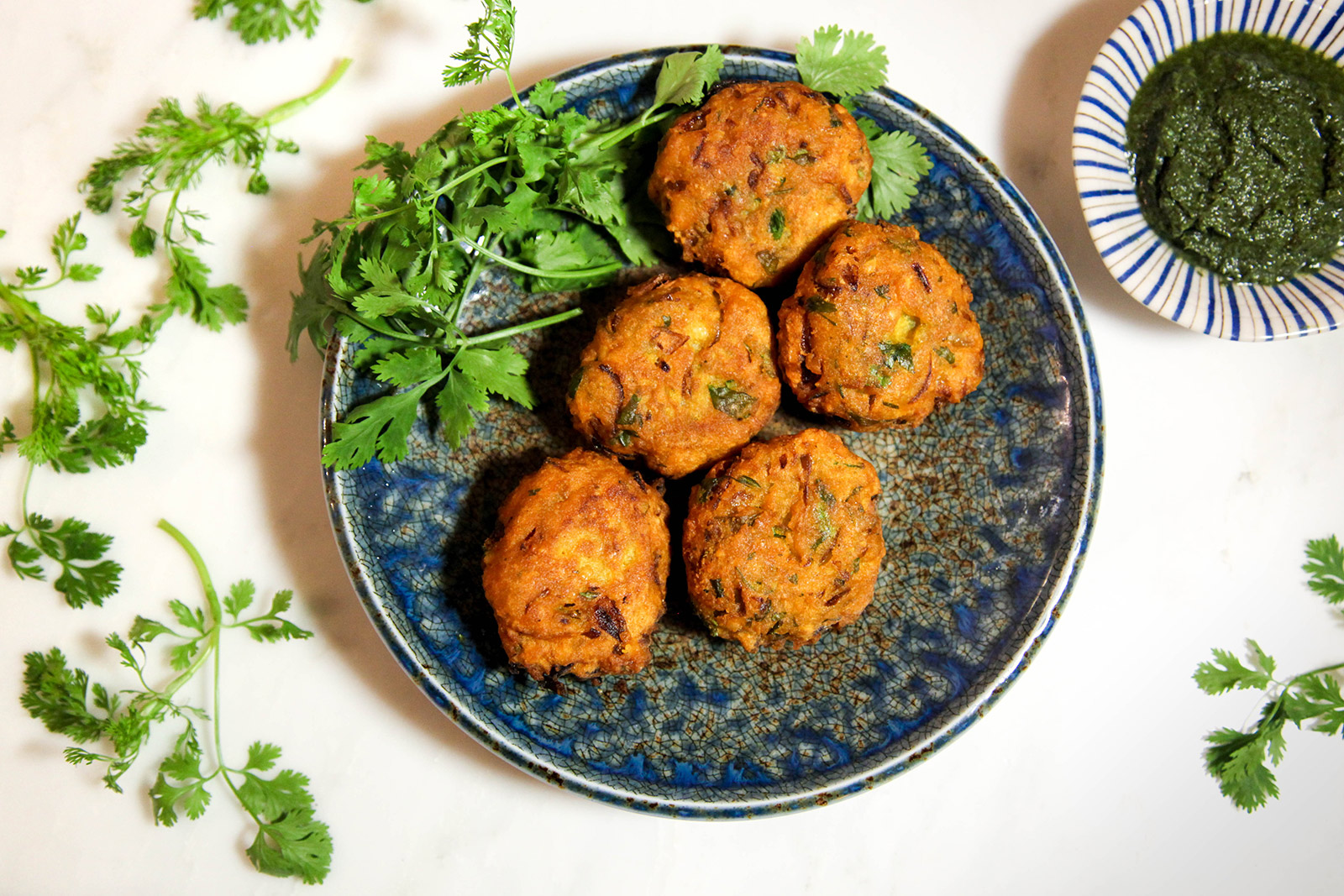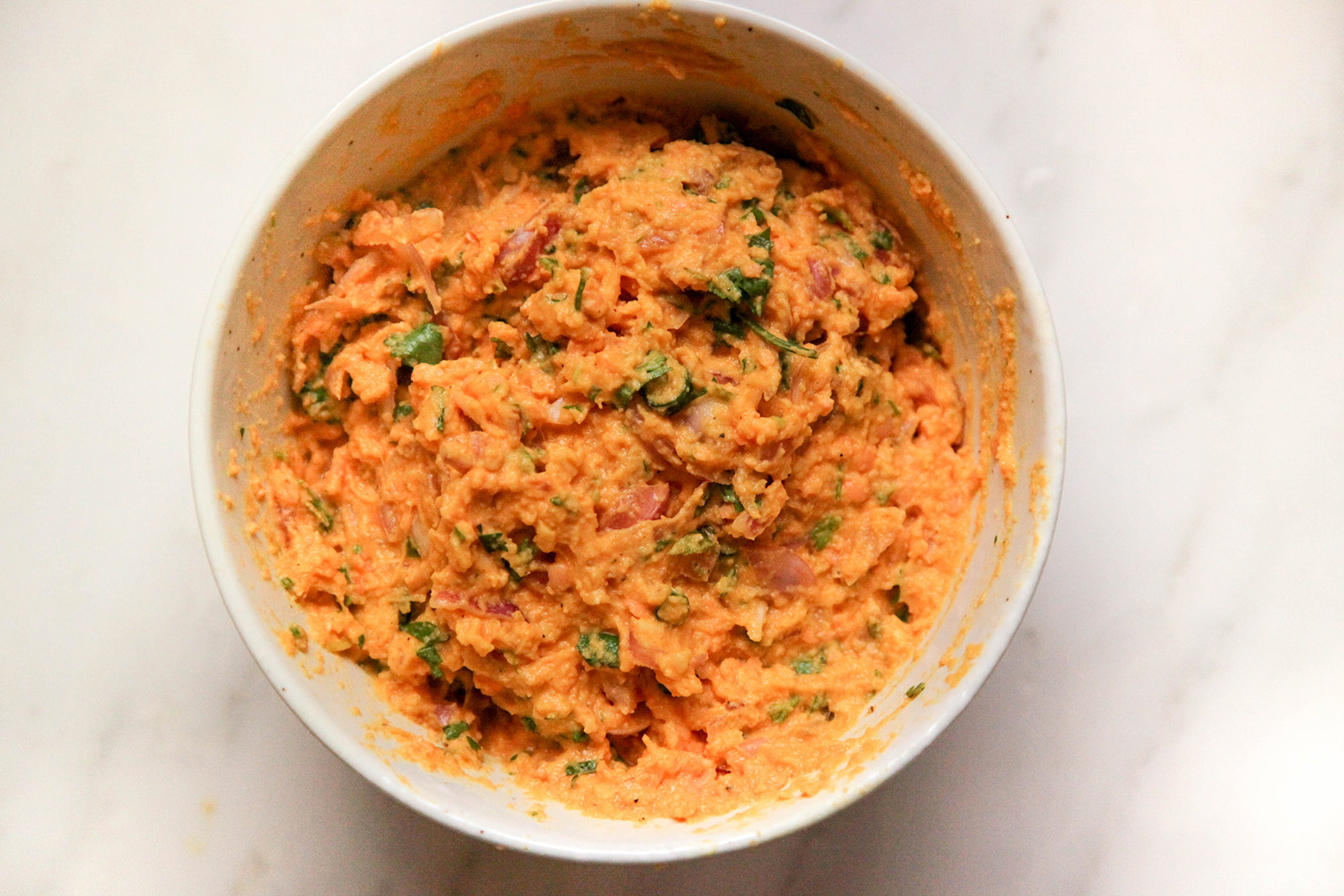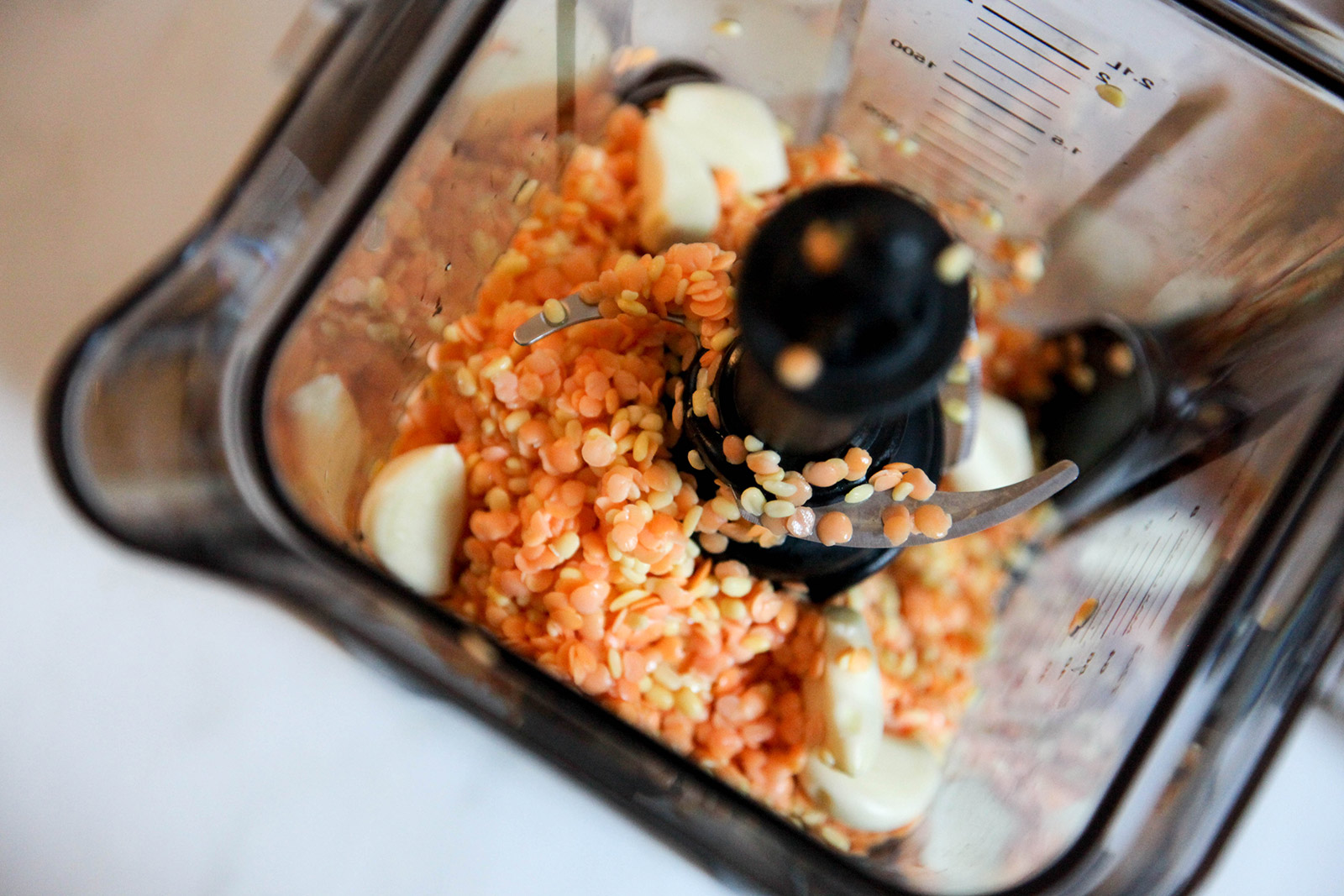Piyaju – Lentil and Onion Fritters
Bangladeshi Piyaju (Ramadan Iftar snack)

In my blog here I have been sharing the food from my childhood in Bangladesh and the context and stories around them. Food back home, when I was growing up, didn’t happen in a vacuum, one didn’t just randomly eat a dish (the way I usually do now as an adult in NYC). Other than the usual staples, what we ate at any given time was usually connected to the season of the year (what was in season drove what we consumed), or there were cultural associations – such as, the Bengali new year, Eid, Ramadan (which we called “Ramzan”). Here, I am sharing the recipe for Piyaju, lentil and onion fritters which we ate during Ramadan.

During the month of Ramzan, we ate special food items that weren’t usually cooked at any other time of the year. While my dad and us kids didn’t fast, my mom, my grandmother and our help usually did, and quite a large variety of special items would be prepared daily for the whole household for Iftar (the meal when breaking the fast). The fast itself could be grueling in the summers, when temperatures would be in the mid-90F’s, and no food or water could pass one’s lips from sunrise to sundown during that month. I don’t know how people who were manual laborers did it. Sitting in an air-conditioned house made it a lot easier to handle fasting. But what I did notice during the month of Ramadan was that people around the city, random people, were a lot nicer, calmer. It seemed as if the process of fasting, along with the spiritual aspect, made the brain ignore irrelevant stupidities, not react in aggressions, but focus on what was important. People just seemed more compassionate. I would be out shopping with my mom more than normal during Ramzan – we would spend hours going from store to store, buying clothes, for our household and to give to people as gifts for Eid (the celebration that would follow the end of Ramadan). So we got to interact with a ton of random people, and oddly enough despite the heat and fasting, I remember seeing less silly petty arguments, etc. as we went around.

Because it was Ramzan and our help were fasting too, we all pitched in to prepare the food. After school, we’d sit together around the dining table, helping prep the ingredients for Iftar. I would help peel a big bowl of black chickpeas that had been soaking and softening in water for hours, or shape little patties or fritters for frying later. It was a lot of fun, doing the meal prep together.
As an adult in NY, when Ramadan comes around, what I miss the most are those afternoons together – all of us chatting, laughing, doing our bits to prepare Iftar. And then excitedly waiting for the moment of breaking the fast, when we’d join the fasting part of the household and drink the rose-scented milk, and eat the food items we had prepared together. Once in a while, during Ramadan now, I’ll make Iftar items from my childhood, and have my sister and others over. I can’t imagine doing Iftar without a group of people around the table.

One of my favorite Iftar items is Piyaju, which are lentil and onion fritters. In our household, we’d eat Piyaju only during Ramzan, but here in NYC, I see them being sold as a snack item throughout the year in the Bangladeshi food places. But their Piyaju is usually oily, so I prefer making my own, the way they’d make it in our house – light, fluffy, crunchy, and not oily. They can be quite addictive actually. The blend of flavors from the fresh ingredients like ginger, garlic, cilantro along with the crunchiness, just makes you want to eat a bunch.
Since the fritters are small in size, about the length of the pinky finger in diameter, you’ll definitely want to make a few. I tend to crave Piyaju usually during Ramadan (like now), but I do make it at random times during the year as a snack. They’re actually fairly easy to make. And totally delicious served hot, with a cup of tea. You need to plan ahead a little bit for making the piyaju, since the lentils will need to be soaked in water for 4 hours or more. Usually, I’ll soak it in the morning, if I’m planning to make piyaju as a snack in the evening. I’ve tried soaking it for 30 minutes in hot water when I didn’t plan ahead, and that still worked, although the piyaju ends up being harder to bite (soaking the dal longer softens it).

I made this batch and took some over to the Bangladeshi fruit vendor who works at a cart a block from our apartment. He fasts every day during Ramadan, while standing in the hot sun, waiting for the neighborhood Manhattanites to come by and buy some fruit. He treks here all the way from the Bronx, and I wonder how he manages to stand there for hours in the heat, not being able to eat or have even a drop of water for over 16 hours, from before 4am to after 8pm. Often when I walk by him in the evenings, he seems tired, but always has a smile on his face, and will greet me and chat. He had just broken his fast when I took these over and was happy to have fresh hot piyaju that smelled so good. As with other cart-vendors around the city, he breaks his fast on the street by his cart, not even being able to indulge in a few minutes of privacy after all those hours not eating. And if a customer comes by, he helps them, without showing any sign of annoyance. I honestly don’t think I would be able to be so gracious after 16 hours of starvation; I’d probably be so hangry! Bringing him the few piyajus was the tiniest little thing I could do, but he was so happy he insisted on gifting me some lychees. Which just made my day!






Piyaju – Lentil & Onion Fritters
YIELD: 12 to 15 fritters/piyajus
INGREDIENTS
- 2/3 cup red lentils, “masoor dal” in Indian stores
- 1/3 cup yellow lentils, “moong dal” in Indian stores (optional, see note below)
- 1/2 teaspoon baking powder
- 3-4 cloves garlic (use less if you don’t like the taste of garlic)
- 1.5 cup shallots, thinly sliced
- 1.5 teaspoon ginger, chopped fine
- 1-3 small green chilies (Thai bird’s eye chili), chopped fine (use less if you want it mildly spicy)
- 1/2 teaspoon freshly ground black pepper (optional)
- 1/4 teaspoon turmeric powder
- 2 tablespoons fresh cilantro leaves, chopped fine
- 1 teaspoon salt (or to taste)
- Oil for deep frying (the oil should be about 1 inch deep in your skillet)
Note: you can use only red lentils for this recipe, you don’t have to use the yellow moong dal; if you’re not using moong dal, make this recipe with 1 cup of red lentils/masoor dal.
METHOD
- Put the red and yellow lentils in a large bowl (bowl should be large enough to hold 2.5 cups). Fill the bowl with tap water and pour out the cloudy water. Repeat this process till the lentils are properly rinsed and the water is clear. Fill the bowl with 2 cups of water and let sit for about 4 hours. I’ve let the dal/lentil sit from morning till evening, and that works. However, don’t let it sit for too long (for example, 24 hours) otherwise, the dal will be too soft and mushy.
- When the lentils have soaked long enough, pour out all the water. I squeeze as much water out of the dal as possible, so it won’t be mushy. Put the lentils in a blender. Peel the garlic cloves, and add to the blender.
- Blend till you get a coarse paste (you should still be able to see the lentil grains, don’t blend to a fine smooth paste). Scoop out the paste into a bowl and let it sit while you prepare the other ingredients.
- Thinly slice the shallots. The slices should be fairly thin, but not super thin (if the slices are too thin, they can burn while frying while the rest of the fritter is still raw). Lightly smash the shallot slices with the back of a big spoon or spatula. Don’t break the slices as you’ll want to retain the texture of the shallots/onions; lightly smashing them releases the flavor of the shallots.
- Finely chop the ginger, green chilies, and cilantro. Add to the sliced shallots. Add freshly ground black pepper.
- Add the shallots, ginger, green chili, cilantro, and black pepper mix to the bowl with the lentil/garlic paste. Mix thoroughly. Add turmeric, salt, and baking powder to the mixture (the baking powder helps make fluffy piyajus), and mix throughly again.
- Take about 2 tablespoons of the mixture and form a little ball. Flatten it slightly, so it’s not too thick – otherwise the outside will cook and the inside will be raw. It shouldn’t be too thin either, otherwise it’ll overcook and burn. The piece should be about the length of your pinky finger in diameter. Continue making the fritter pieces till you have no more lentil mixture left. See photo for what the uncooked fritter pieces should look like.
- Take a small but fairly deep skillet and add oil. The oil should be about 1 inch deep. If you use a small skillet, you’ll need less oil, and it’s easier to fry the piyaju in small batches. Heat the oil for about 2 to 3 minutes on medium low heat.
- Once the oil is hot (you can drop in a shallot slice to test; if the oil starts bubbling, it’s hot enough), carefully slide in a fritter piece using a wide slotted spoon. My skillet fits 4 pieces comfortably; make sure you leave enough room so that the fritter pieces don’t stick to each other. Fry for about 2 minutes, and then flip over (watch to make sure the bottom isn’t burning); each side should be golden brown.
- Carefully remove the fried fritters from the skillet using a slotted spot, and put on paper towels to absorb the oil. Add the next batch to the skillet.
When all the fritters are done, serve hot and eat right away. You can serve with a chutney, (such as coriander chutney). The piyajus are delicious. Enjoy!



Hello! I made this last night & it turned out perfect. Thank you for sharing this lovely recipe..
A couple of improvisations:
– I only used masoor dal (as that’s all I had) and 1/2 a cup of it (still yielded 10-12 piajus).
– I also used more onions as I like my piajus to be onion heavy..
I would post a photo – but don’t know how?
So happy you made them! And more onions sound good 🙂 I’m going to have to make oniony ones too, craving piyajus.